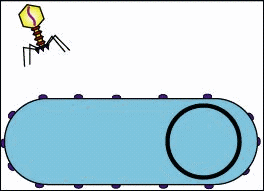
Viruses
A virus borders the line between non-living and living. According to the textbook, they are not alive; however this fact is highly contested. Essentially a virus is a piece of genetic material surrounded by a protective layer called a capsid with glycoproteins and glycolipids on top of the capsids. The glycolipids and proteins are used by the virus to attach itself onto the host cell. The capsid serves as protection for the genome and comes in a variety of shapes. The capsid is constructed from proteins. The genetic material in a virus is used to reprogram a host cell to create more of the same virus. The genetic material in viruses can be regular DNA, single-stranded DNA, regular RNA, or double-stranded RNA. Two examples of viruses are HIV and Ebola.
The discovery of viruses came from scientist analysis of Tobacco Mosaic Disease. In 1883, a scientist called Adolf Mayer (NOT WHO YOU WERE THINKING OF WHEN YOU READ "Adolf") discovered that this disease in tobacco plants could be transferred through the sap the diseased plant produced. However, after analyzing the sap, he could not find any bacteria that would cause any disease. Next a scientist called Dimitri Ivanowsky tried to filter the sap with a filter designed to remove bacteria in 1893. The filtered sap still transmitted the disease. Finally, another scientist, Wendell Stanley, crystallized the sap. In the crystallized sap, he identified what is now known as a virus. Today we estimate there are more than 100,000,000 virus species in the world. Examples of viruses include influenza, Ebola, HIV, and many other types of viruses.
Viruses reproduce in two very different ways. These are called the lytic cycle and the lysogenic cycle. The lytic cycle begins with the attachment of the virus to a host cell. The virus than injects its DNA into the cell and alters the host cell's DNA. The cell than produces copy of the viral genome and the proteins necessary for building a capsid. The cell than assembles the new virus inside of itself.
Finally, the cell explodes, releasing the viruses. The lysogenic cycle takes a slightly different path. Like the lytic cycle, the lysogenic cycle begins with the virus inserting its DNA into the host cell. However, unlike the lytic cycle, the cell than reproduces into new cells with viral DNA. This cycle can repeat many times. Finally, the cells produced from the original host undergo the lytic cycle to produce millions of viruses. The many differences between the lytic cycle and the lysogenic cycle is that in the lysogenic cycle, the cell does not explode (until it undergoes the lytic cycle, but that is treated separately), and phage components are not created in the lysogenic cycle. Diagrams are below, and are probably more useful than my giant paragraph above.
EVERYTHING you need to know about viruses....in 23 minutes. By:Khan Academy
 66.png |
|---|
 18_07LamdaLyticLysoCycle.jpg |
 HIV.jpgthe HIV virus |
 140727-ebola-jms-2109_f8eada30a725d312b7c5791a8f9fd5e8.jpgEbola |
 adenoviruses-human.jpgA human adenovirus |
 image.jpgInfluenza |
 phage2.gifThe lytic cycle preformed by a bacteriophage |
By: Derek Hu